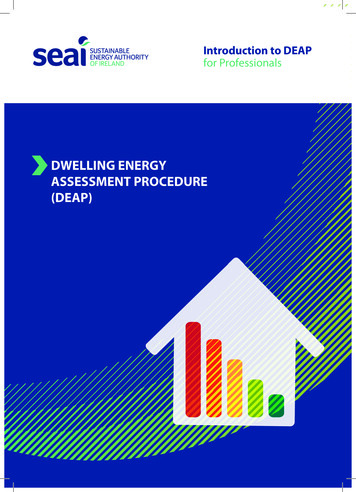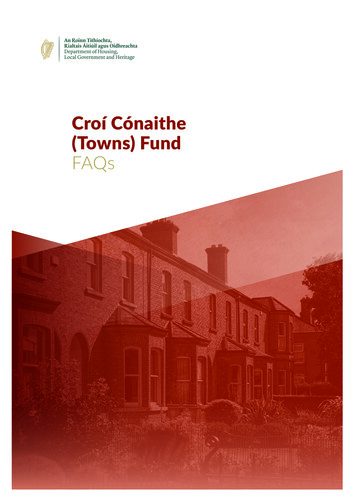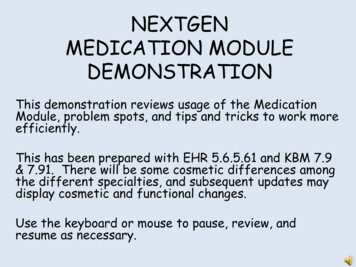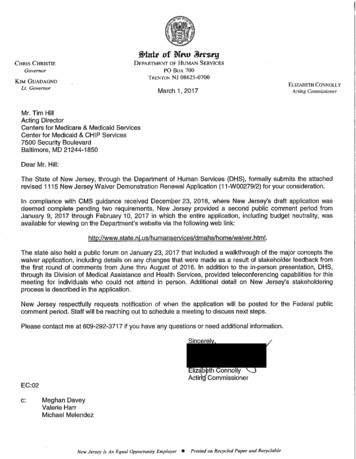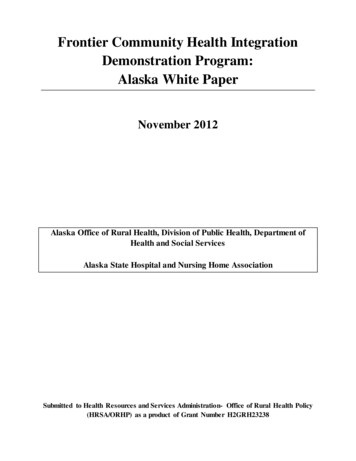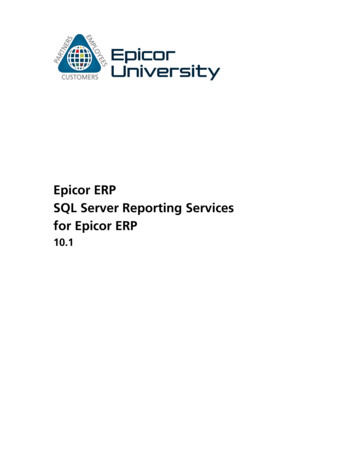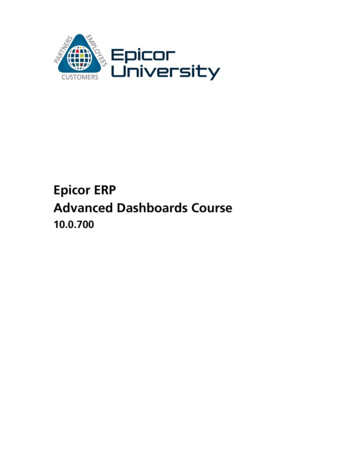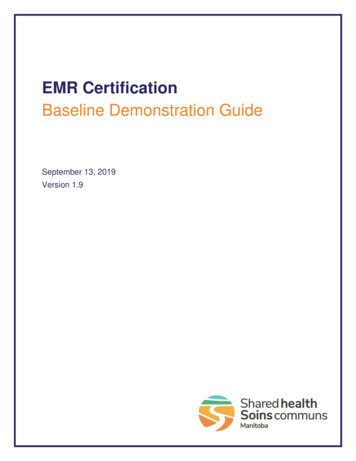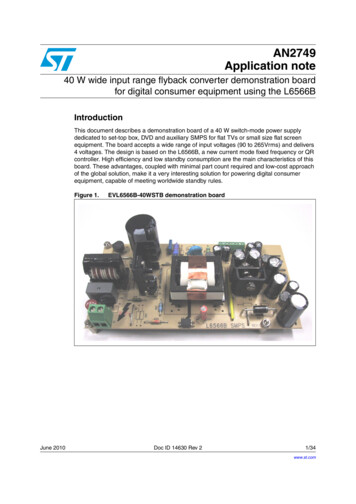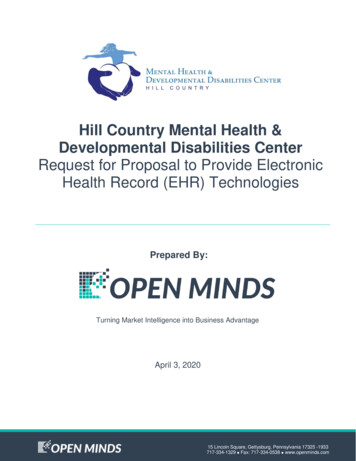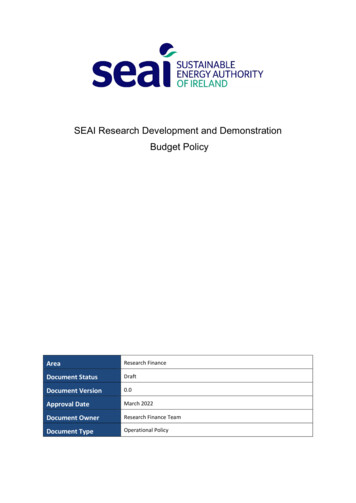
Transcription
SEAI Research Development and DemonstrationBudget PolicyAreaResearch FinanceDocument StatusDraftDocument Version0.0Approval DateMarch 2022Document OwnerResearch Finance TeamDocument TypeOperational Policy
Contents1. Introduction . 21.1 SEAI Research Funding . 22. Eligible Costs . 32.1 Budget Categories. 32.1.1 Staff . 32.1.2 Postgraduate Fees . 62.1.3 Materials . 62.1.4 Equipment . 62.1.5 Travel . 72.1.6 External Consultants . 82.1.7 Overheads . 92.2 VAT. 93. Funding Rate . 113.1 Research Categories . 123.2 Company Sizes . 133.3 Effective Collaboration . 143.4 SEAI Funding of Companies . 143.4.1 Eligible Companies . 143.4.2 Linked 3rd Parties / Affiliated Entities . 153.4.3 Undertakings in Difficulty . 164. Financial Declarations & Documentation . 17Appendix 1: Budget Template Instructions. 18Appendix 2: Ineligible Costs . 211
1. IntroductionThis policy describes Sustainable Energy Authority of Ireland’s (SEAI’s) budgetary policies and financialrequirements in relation to both Research, Development & Demonstration (RD&D) FundingProgramme grant applications as well as financial management of RD&D grants awarded.1.1 SEAI Research FundingSEAI is Ireland's national sustainable energy authority. SEAI’s remit in respect of research activities isto lead and support excellent research, development, demonstration & innovation activities, to be atthe forefront of knowledge generation relevant to the energy sector, and to promote its applicationin policy and practice.SEAI research funding programmes are open to public and private sector organisations based inIreland (including Irish subsidiaries of overseas companies) who wish to carry out projects in Ireland.In some circumstances, the programmes may support Irish entities on work undertaken overseas,where this is necessary for the completion of the work. In exceptional cases, funding of work overseasmay be supported where there is a demonstrable contribution to resolving specific Irish issues.Applications will be accepted from companies, 3rd Level Educational Bodies, Public Sector Bodies andSemi-State Bodies who are based in the Republic of Ireland.2
2. Eligible CostsEligible costs are those actual, necessary, and economic costs that are incurred during the grantduration. The SEAI grant may not have the purpose or effect of producing a profit for award holder(s).SEAI must be the only project funder and will not consider applications where SEAI are considered asa partnership funder, except where SEAI’s existing pre-defined co-funding arrangements are in place.Only costs directly associated with delivery of a project are considered eligible costs. Value for moneymust always be sought and achieved by Lead/Partner Applicants, and where relevant, publicprocurement procedures must be observed.Eligible costs must be recorded in the Lead/Partner Applicant organisation’s accounts and bemaintained throughout the duration of the project. The SEAI RD&D funding programme funds actualcosts incurred on a reimbursement basis.Applications should detail all costs that are wholly and exclusively necessary for carrying out theproject as part of their application to ensure eligibility should their project be funded.Examples of ineligible costs for SEAI RD&D Funding Programmes are provided in Appendix 2 of thisdocument.Please note for successful awards, all cost categories are separate contributions from SEAI. Funds fromone category cannot contribute to another category without prior agreement from SEAI.2.1 Budget Categories2.1.1 StaffStaff costs are costs associated with new or existing staff within an organisation working on the fundedresearch project. Eligible staff costs comprise actual salaries plus social security contributions andother statutory costs included in the remuneration, provided that these costs are in line with theLead/Partner Applicant organisation’s usual policy on remuneration. The salary costs should notexceed the rates corresponding to the Lead/Partner Applicant(s) organisation's usual policy onremuneration.Pension contribution costs are not eligible costs, except in the instance of pension paid by 3rd leveleducation bodies at IUA scales whereby the pension is charged at payroll source. In all other cases,budget for main pay and revenue employer costs only.Staff costs for project administration/non-technical project management should be no more than 10%of total staff costs. Where such roles are requested, clear rationale and justification must be providedtogether with a description of the qualifications required for an individual to be hired.Please note for successful awards: for periodic financial reporting, signed timesheets, payslips, andcorresponding proof of payment may be required for each staff member.3
Companies and Public/Semi-State BodiesFor companies and Public/Semi-State Bodies, SEAI calculates full time basis salary as 7.5 hours per day / 37.5 hoursper week over a 230-day working year. If the employee is not full time, appropriate documentation must beprovided to show this (e.g. contract of employment). Applicants may be requested to submit evidence of salaryscales in use by the organisation to verify rates used. The maximum eligible staff day cost is 400. Please see tablebelow for the staff cost calculation with worked example below,Number of Hours per Month(H)Monthly Rate (MR)PRSI ClassHours worked on the project reported on signed and approvedtimesheetsThe monthly gross salary amount for the person working on the project(taken from corresponding payslips)The bi-weekly gross salary amount for the person working on the project(taken from corresponding payslips)Employer PRSI class taken from corresponding payslipsPRSI Rate (PRSI)PRSI rate applied according to the appropriate PRSI ClassYearly Rate (AR)Calculated as Monthly rate (MR) multiplied by 12 (OR Fortnightly rate(FR) multiplied by 26)Calculated as Yearly rate (AR) divided by 230 working days andmultiplied by the PRSI rate (PRSI) and capped at 400Number of Hours per Month (H) divided by the standard 7.5 workinghoursDaily Rate (DR) * Number of Days (D) Total eligible staff costFortnight Rate (FR)Daily Rate (DR)Number of Days (D)Eligible Cost Yearly rate (AR) Monthly rate (MR) * 12 OR Fortnight rate (FR) * 26Number of Days (D) Number of Hours per Month (H) / 7.5 hoursDaily rate (DR) (Yearly rate (AR) / 230 days) * (1 PRSI)Eligible cost Number of Days (D) * Daily rate (DR)Example 1 – Staff cost calculations (daily rate cap NOT applied)Jane Doe is working on a project and her payslips show a gross monthly salary of 5,000 (Monthly rate (MR)).Signed and approved timesheets show she has worked 150 hours in the period January – April, 175 hours in Mayand 130 hours in June (Number of Hours per Month (H)). Please see below the calculation route for eligible staffcosts for Jane Doe (please note that the daily rate cap does not apply as the gross annual salary divided by 230days is less than 400).Jane DoeNumber of Hoursper Month (H)Monthly Rate 5130 5,000.00 5,000.00 5,000.00 5,000.00 5,000.00 5,000.00Fortnight Rate (FR)N/AN/AN/AN/AN/AN/APRSI ClassA1A1A1A1A1A1PRSI Rate (PRSI)11.05%11.05%11.05%11.05%11.05%11.05%Yearly Rate (AR) 60,000.00 60,000.00 60,000.00 60,000.00 60,000.00 60,000.00Daily Rate (DR) 289.70 289.70 289.70 289.70 289.70 289.70Number of Days (D)2020202023.3317.33Eligible Cost 5,794.00 5,794.00 5,794.00 5,794.00 6,758.70 5,020.504
Please note the rows in blue are inputs from corresponding timesheets and payslips, the rows in white arecalculations. January calculation route from example above: Yearly rate (AR) Monthly rate (MR) * 12 5,000.00 * 12 60,000.00Number of Days (D) Number of Hours per Month (H) / 7.5 hours 150 / 7.5 20 daysDaily rate (DR) (Yearly rate (AR) / 230 days) * (1 PRSI) ( 60,000.00 / 230) * 1.1105 289.70Eligible cost Number of Days (D) * Daily rate (DR) 20 days * 289.70 5,794.00It should be noted that salary costs are only eligible once they are not funded from any other sources. Thepertinent question to address is whether the salary of the position would be paid regardless of if the grantapplication is successful? If the answer is yes, then the salary costs of the position are ineligible.3rd Level Educational BodiesFor 3rd Level Educational Bodies, SEAI will make a contribution to the salary as per the Irish UniversitiesAssociation salary guidelines salary-scales/), and should bebudgeted from first point of the relevant salary scale.Please note, for 3rd Level Educational Bodies, the named Lead Applicant must be a core funded member ofacademic staff or a member of academic staff with a fixed-term contract and is ineligible to receive salaryfunding through the SEAI RD&D Funding Programme. The duration of the fixed-term contact should have anend date later than the proposed end date of the project. Postdoctoral Researchers or Research Fellows may notbe listed as the Lead Applicant (except for Fellowship applications), however, Fellowships are not permitted tobe partners.SEAI does not fund the salary of staff within Irish 3rd Level Educational Bodies that are already in receipt ofsalaries funded from other sources. Applications should not name individuals, but rather request funding for therequired staffing skillset at the appropriate level to carry out to described project specific tasks. It is SEAI’sexpectation that organisations conduct an open and transparent recruitment process, the details of which maybe requested for audit purposes.The award of Masters and Doctoral scholarship funding is restricted to 3rd Level Educational Bodies in theRepublic of Ireland. The person who intends to be the academic supervisor for such projects must make theapplication for scholarship funding as part of an application for a small, medium, or large-scale project. PhDstudents will only be funded for projects of a minimum 36-month duration. SEAI will provide a maximum annualcontribution of 18,500 towards scholarship stipends for up to 48 months. Please note that postgraduate fees(please see section below) and stipends are two separate contributions from SEAI. The stipend must not be usedto contribute to student fees under any circumstances.Research Fellowships funded by any SEAI research grant must be filled at Post-Doctorate Researcher level (Level2) or Research Fellow level (Level 3) as defined by the IUA Salary Guidelines. Please note, the annual budget costper staff member consists of full employer staff cost, per the IUA salary scales, of gross salary and full employer’scharges (PRSI and pension) and should be budgeted from the first point on the scale. SEAI expects that salaryrequested at a higher point on the scale will generally align with the number of years’ post-PhD experience, withone point being applied for each year.5
2.1.2 Postgraduate FeesSEAI will provide a maximum annual contribution of 6,000 towards postgraduate fees, for up to 48months. Please note that postgraduate fees are not included in the calculation of the overheads.2.1.3 MaterialsMaterials costs are defined as,“Goods and services that are consumed by the project and not placed on an equipment inventory or treatedas capital expenditure in accordance with the accounting conventions and policies of the award holder’sorganisation and have a life expectancy not greater than the duration of the project. Materials costs must beseparately identifiable and necessary for the project.”Typical examples of costs required to carry out the research include but is not limited to materials andconsumables, and access costs to research infrastructure.Applications should outline all materials that will be used during the proposed work programme andprovide a detailed justification for all costs such as quotations. The most accurate costing availableshould be provided. Quotations justifying costings may be requested by SEAI.Dissemination costs, publication and open access costs should also be included under this budgetcategory.When claiming costs for reimbursement, an invoice, and proof of payment may be required for eachitem. Proof of compliance with National and EU procurement guidelines may be requested.2.1.4 EquipmentEquipment costs are defined as,“Items that are essential for the effective implementation of the project, that are placed on an equipmentinventory or treated as capital expenditure in accordance with the accounting conventions and policies ofthe award holder’s organisation.”Costs are eligible for the duration that the item is specifically used on the project.Costs of software purchased (perpetual licences, with no recurring cost) may also be entered in thisbudget category. Depending on the award holders accounting conventions laptops and desktopcomputers may be deemed to be either equipment or materials.Applications should list and describe all equipment requested and provide a detailed justification forall costs. The most accurate costing available should be provided. Quotations justifying costings maybe requested by SEAI. The duration that the asset will be used on the project (in months) must beprovided. This cannot be longer than the project duration. The location of the equipment should beclearly indicated and justified in the budget justification.Please note that the full cost of the equipment may not be claimed during the project as the eligiblecost of equipment will be determined by the depreciation period.6
Depreciation PeriodTo calculate the depreciation period, computer equipment is depreciated over 3 years and other equipment over5 years, using the following calculation: (A/B) x C x DA Number of months equipment is used for the project after invoicingB The depreciation period (for example 36 months for computing equipment)C The actual cost of the equipmentD Percentage of usage of the equipment for the projectFor example, assume a project has a two-year duration from January 2022 to December 2024. An item ofcomputing equipment is purchased on the 1st of July 2021 for 15,000. The computing equipment is 100% usedon the project.The eligible equipment cost claimable will be 7,500 [(18/36) * 15,000*100%].In the above example if other equipment was included in the proposal the eligible equipment cost claimablewould be 4,500 [(18/60) * 15,000*100%].Please refer to the Guide for Grantees for more detailed equipment cost calculation examples.When reporting of costs for reimbursement, an invoice, and proof of payment may be required foreach item. Proof of compliance with National and EU procurement guidelines may be requested.SEAI, where possible, encourages the use of existing equipment and that a plan is in place for theequipment once the proposed project is completed.2.1.5 TravelActual, directly necessary, and economic travel costs of project personnel for successful delivery ofthe project are reimbursable. Journeys must be carried out by the most direct and economic route.Applications should provide a short description that includes What is the destination of travel?Who is undertaking travel?What is the purpose of travel?Examples include travel costs associated with attendance at workshops and conferences fees. Themaximum eligible budget for this is capped at 1,500 per year per researcher (Lead/Partner Applicantsor funded team member)Where travel costs are incurred by employees involved in the project and such costs are reimbursedby the Lead/Partner Applicant organisation on a per diem basis then it is the per diem payment thatis considered to be the eligible cost. All lump sum or per diem payments in this regard must be inkeeping with the normal practices of the Lead/Partner Applicant organisation and must not exceedcurrent civil service subsistence or other Revenue Commissioners approved rates.Where researchers outside the State are required by the project to attend project meetings in Ireland,their costs will be deemed eligible subject to appropriate justification being provided in the originalsubmission by the Applicant(s). The eligibility of such travel will be contingent upon adequate budgetand will only be approved where deemed necessary and sufficiently beneficial to the project.7
Eligibility of all travel costs will be based on the Applicant’s original submission and appropriatejustification being provided by the Applicant(s).In addition to the travel costs referred to above, if the defined project objectives necessitate additionaltravel, outside of general project-related travel, Lead/Partner Applicants should provide a detaileddescription of these activities, and appropriate justification, within Section 5 (Budget) of theApplication Form. Examples include the following Regular site visits for project equipment maintenanceRegular travel to project management team meetings (e.g., a project with multiple partnersacross different geographical areas where regular in-person meetings are necessary forsuccessful project implementation)Regular site visits for data gathering/sample collectionTravel costs relating to roles not outlined in the application are not eligible for reimbursement.Travel costs incurred when using company vehicles is not an eligible cost.When reporting mileage costs for reimbursement, please have the following information available ifrequested: the vehicle details, rate per kilometre, departure & destination points (undertakingshortest duration), number of kilometres, proof of payment, and purpose and necessity of journey.For all other travel costs when reporting for reimbursement, an invoice, and proof of payment may berequired.2.1.6 External ConsultantsEvery possible effort must be made, in the first instance, to build a project team capable of completingall tasks proposed in the project without the need for external consultants. However, where this is notfeasible, costs associated with external consultants/service providers may be included within theproject costs subject to obtaining value for money. Where such external assistance is proposed, strongjustification should be provided. Proof of compliance with National and EU procurement guidelinesmay be requested.External consultant costs are costs of external labour, sub-contractors, specialist consultancy andequivalent services that are used exclusively for delivery of the project. SEAI funds subcontractedtasks that are separately identifiable and cover only a limited part of the project. For the avoidance ofdoubt, core tasks defined in the Work Plan (Section 4) cannot be subcontracted and externalconsultants should not be listed as a collaborator or partner.Eligible external consultant costs may not have linked 3rd party or affiliated entity status (See Page 11for further details). The transaction must be carried out at arm’s length and under conditions oftransparency.Where the services of a sub-contractor or consultant are required, as part of an application forfunding, these should not normally constitute more than 20% of the total budgeted expenditure ofeach individual Lead/Partner Applicant organisation. Sub-contract and consultancy arrangements aresubject to a maximum daily rate for external assistance of 600 VAT.Any costs in excess of the daily rate of 600 VAT will be deemed to be ineligible and removed fromthe budget.Sub-contract arrangements between Lead and Partner Applicant organisations are not permitted.Core elements of any funded project may not be sub-contracted.8
2.1.7 OverheadsAs part of the budget, SEAI will contribute to the indirect costs of project-based research work that itsupports through an overhead payment calculated by 25% of Staff costs. Staff costs are salaries andstipends only, and do not include student fees. Grantee organisations are responsible for ensuringthat the indirect Costs are correctly spent in providing the central support that underpins SEAI fundedresearch projects and programmes.It should be noted that overheads may increase/decrease during the project as a result of the GrantAmendment Process, however, overheads may not be allocated into the eligible cost categories listedabove.2.2 VATWhere an Applicant organisation is registered for Value Added Tax (VAT) and is entitled to reclaim VATincurred on eligible costs, then all expenditure items included in the application for funding andsubsequent claims for reimbursement should be shown exclusive of VAT.SEAI will assume projects are being applied for on a VAT exclusive basis.However, where a Lead/Partner Applicant organisation is not entitled to reclaim VAT on eligible coststhen the amounts included in their application for funding and subsequent claims for reimbursementshould be the VAT inclusive amount. To be eligible for reimbursement on a VAT inclusive basis thefollowing conditions apply,Companies and Public/Semi-State BodiesMust provide a letter from the Revenue Commissioners with the application which confirms the VAT status ofthe Lead/Partner Applicant organisation in the year the grant. The letter from the Revenue Commissioners muststate that the Lead/Partner Applicant organisation is not entitled to reclaim VAT on costs related to theLead/Partner Applicant organisations, insert project title , activity. A statement confirming the Lead/PartnerApplicant organisation is not registered for VAT purposes will not suffice.3rd Level Educational BodiesThe supply of research services by educational bodies is subject to VAT only in certain circumstances. 1In line with Revenue guidelines, it is SEAI’s expectation that where a 3rd level educational body selects theresearch category ‘Non-economic Public Good Research’, the grantee will not be entitled to reclaim VAT onrelated expenditure, and therefore costs reimbursement will be VAT inclusive.In this case, the 3rd Level Education Body Non-Economic Public Good Declaration must be submitted with theapplication.Where a 3rd Level Education Body selects any of the following research categories: Industrial Research orExperimental Development, it will be SEAI’s expectation that the proposed research to be conducted is of aneconomic nature, and therefore costs claimed will be exclusive of VAT, unless otherwise clarified in writing bythe Revenue Commissioners.1 l-bodies-research.pdf9
Responsibility to determine the VAT status of any particular case or activity lies with the Lead/PartnerApplicant. SEAI encourages Applicants to verify the VAT status of their activities with their local RevenueDistrict, and to do so on a timely basis to avoid any unnecessary delay in obtaining the required paperwork tosubmit applications to SEAI.10
3. Funding RateSEAI’s National Energy Research, Development & Demonstration (RD&D) Funding Programme issubject to the General Block Exemption Regulation (GBER, EU Commission Regulation (EC) No.651/2014, under which Article 25 apply in respect of different categories of research, developmentand demonstration projects 2. This regulation sets limits on the levels of funding support that can beprovided by national authorities. The maximum funding level for which a project is eligible dependson the Category of RD&D the project falls under.EU state aid rules stipulate what types of activities are eligible for support, which costs relating tothese activities may be covered in part or in full, and the maximum aid intensity that may be grantedfor the various activities.Support from SEAI constitutes state aid when it is awarded to an "undertaking", i.e. an actor thatcarries out an economic activity consisting of offering products or services on a given market.3rd Level Educational Bodies and Public/Semi-State BodiesIt is recognised that 3rd Level Educational Bodies and Public/Semi-State Bodies can engage in research activitiesrelating to non-economic activity, in the public interest, where knowledge is widely disseminated. This activitydoes not constitute state aid in the meaning of EU rules.In this case, the organisation may be eligible to request up to 100% SEAI funding. Applications must include aNon-Economic Public Good Research Declaration if requesting to be funded as exempt from State Aid. Thereare separate Declarations for 3rd Level Education bodies (in response to specific VAT for research Revenuepublication).CompaniesThe maximum level of support that a company can be awarded is capped at 80%.The onus is on the Lead/Partner Applicant organisation to select a research category whichappropriately reflects the proposed project activities.The Categories below represent the maximum level of support that could be available.COMMISSION REGULATION (EC) No 651/2014 declaring certain categories of aid compatible withthe common market in application of Articles 107 and 108 of the Treaty:2 Article 25: Aid for research and development and innovation: fundamental research, industrialresearch, experimental development and feasibility studies11
RD&D activities subject to EU State Aid RegulationsResearchCategoryBase LevelType of laborationMaximumSupportIndustrialResearch50% of approveditemised eligible costs 20% 10% 15%80%ExperimentalDevelopment25% of approveditemised eligible costs 20% 10% 15%60%RD&D activities not subject to State Aid RegulationsNon-economic Public Good Research100%3.1 Research CategoriesA definition of the various research categories is outlined below,Industrial ResearchA project where the planned research or critical investigation is aimed at the acquisition of new knowledge andskills for developing new products, processes, or services, or for bringing about a significant improvement inexisting products, processes, or services. It comprises the creation of components parts of complex systems andmay include the construction of prototypes in a laboratory environment or in an environment with simulatedinterfaces to existing systems as well as of pilot lines, when necessary for the industrial research and notably forgeneric technology validation.Experimental DevelopmentAcquiring, combining, shaping, and using existing scientific, technological, business, and other relevantknowledge and skills with the aim of developing new or improved products, processes, or services. This may alsoinclude, for example, activities aiming at the conceptual definition, planning and documentation of newproducts, processes, or services.Experimental development may comprise prototyping, demonstrating, piloting, testing and validation of new orimproved products, processes, or services in environments representative of real-life operating conditions wherethe primary objective is to make further technical improvements on products, processes or services that are notsubstantially set. This may include the development of a commercially usable prototype or pilot which isnecessarily the final commercial product, and which is too expensive to produce for it to be used only fordemonstration and validation purposes.Experimental development does not include routine or periodic changes made to existing products, productionlines, manufacturing processes, services, and other operations in progress, even if those changes may representimprove
a partnership funder, except where SEAI's existing pre-defined co-funding arrangements are in place. . Please note for successful awards: for periodic financial reporting, signed timesheets, payslips, and . Companies and Public/Semi-State Bodies : For companies and Public /Semi-State Bodies, SEAI calculates full time basis salary as 7.5 .
